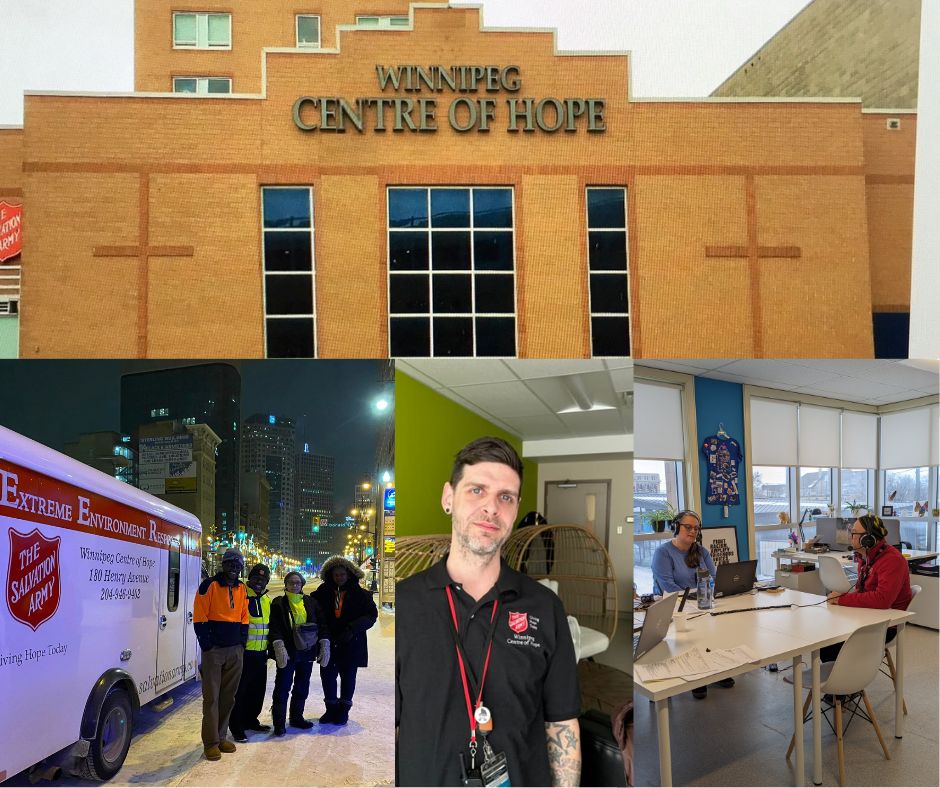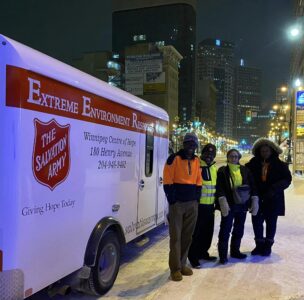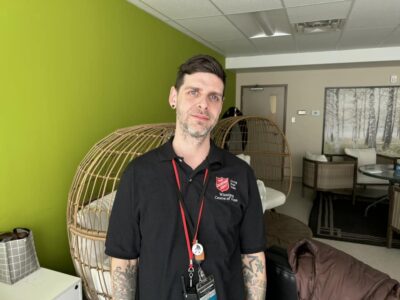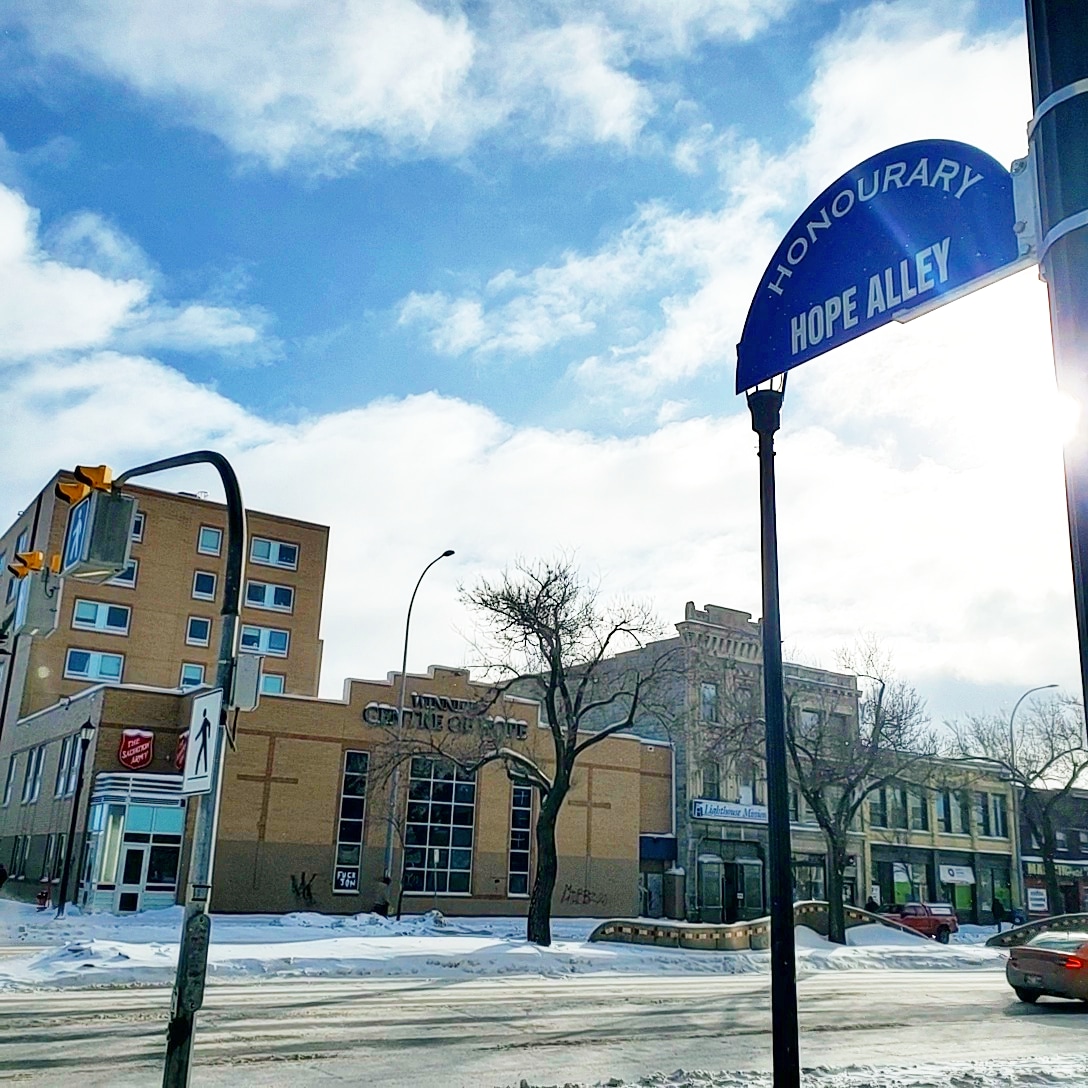Busting Myths About Homelessness Part 2

In March, CBC Manitoba Information Radio spent the morning broadcasting live from The Salvation Army Winnipeg Centre of Hope. Host Marcy Markusa and producer Cory Funk talked with clients and staff to get a sense of the reality of shelter life and uncover and dispel commonly held myths about the people who rely on shelter services.
If you missed part one, you can read the excerpts and hear the interviews in Busting Myths About Homelessness Part 1.
Below, you can hear interviews with residential services supervisor James Paulson and Captain Samuel Tim, who brought Funk on an overnight ride along in the mobile outreach vehicle, intake worker Steven Hunter, and Centre of Hope executive director Mark Stewart.
Mobile Outreach
 CBC Producer Cory Funk accompanied Residential Services Supervisor James Paulson and Captain Samuel Tim on a ride-along in the Extreme Environment Response Vehicle. The vehicle roves the city from 10 pm until 3 am to check on community members, particularly in areas where there is a high degree of human trafficking activity. They offer rides to shelter or a safe place, warm clothing, food when available, and other types of aid. Often, they will circle back hourly to check on vulnerable individuals.
CBC Producer Cory Funk accompanied Residential Services Supervisor James Paulson and Captain Samuel Tim on a ride-along in the Extreme Environment Response Vehicle. The vehicle roves the city from 10 pm until 3 am to check on community members, particularly in areas where there is a high degree of human trafficking activity. They offer rides to shelter or a safe place, warm clothing, food when available, and other types of aid. Often, they will circle back hourly to check on vulnerable individuals.
Funk spoke with three individuals who declined rides to the shelter but were grateful for the check-in and items offered.
“For me, Salvation Army provides emergency assistance when the essentials are needed or lost… Their friendliness and compassion attributes to a sense of belonging, whether it’s to yourself that day or for a goal down the way,” said one person who received gloves from the team.
That evening the mobile outreach team spoke with around 45 people including a 13-year-old girl who accepted a ride to her home across town at 1 am. On an average night the team typically speaks with between 50 and 75 and administers naloxone several times per week.
LISTEN: https://www.cbc.ca/listen/live-radio/1-29/clip/16047284
Related – A female perspective: https://www.cbc.ca/listen/live-radio/1-29/clip/16047288
Intake Worker
Intake worker Steven Hunter talked about the variety of reasons people come to the Centre of Hope. While the prevailing assumption is that most clients are burdened by addiction, many also come because they are dealing with family or intimate partner violence or simply aren’t making enough money. Hunter, a lived-experience employee who stayed at the Centre during a difficult period of his life, says it’s hard to access resources and to have the courage to ask for help.
“Having staff with resources on hand for those people who are ready to get out of that lifestyle and make the switch. A lot of the time, when people are ready to do it, they need they need the help now, not next week or next month.”
LISTEN: https://www.cbc.ca/listen/live-radio/1-29/clip/16046935
Related – Watch Steven’s Story of Hope on YouTube
Executive Director
 Executive Director Mark Stewart discussed how the emergency shelter is open 24 hours a day, seven days a week, and they never want to turn anyone away, but recently, they have been serving over 400 people per night, meaning their resources are being stretched to their limits. A recent influx of refugees and asylum seekers to the province of Manitoba is adding additional pressure, as many come to Winnipeg without a place to stay and need an emergency shelter bed. In the early months of 2024, there were an average of 120 refugees staying at the Centre of Hope each night. Stewart also discussed the Haven program, which provides transitional housing for up to two years, along with resources and services for men experiencing mental health crises.
Executive Director Mark Stewart discussed how the emergency shelter is open 24 hours a day, seven days a week, and they never want to turn anyone away, but recently, they have been serving over 400 people per night, meaning their resources are being stretched to their limits. A recent influx of refugees and asylum seekers to the province of Manitoba is adding additional pressure, as many come to Winnipeg without a place to stay and need an emergency shelter bed. In the early months of 2024, there were an average of 120 refugees staying at the Centre of Hope each night. Stewart also discussed the Haven program, which provides transitional housing for up to two years, along with resources and services for men experiencing mental health crises.
Stewart addressed two of the most pervasive myths about homelessness. The first is that older adults don’t rely on the shelter system, when in fact, the average person staying at the Centre of Hope is a male in his mid-fifties. Stewart says that the Centre of Hope’s ability to provide single rooms with locked doors goes a long way toward making folks feel safe and like they have a space of their own. The second myth is that everyone using an emergency shelter is there as a result of addiction when actually, there are many factors, including financial hardships and a lack of affordable housing options.
He says that while the current model of emergency shelter is ultimately not sustainable and the goal is affordable long-term housing, he expressed gratitude and optimism for the agencies working together towards that solution.
“Being a lived-experience leader, the thing that you need to understand, which is very difficult to understand, is that true feeling of hopelessness and loss when you have no choice – when you’ve run out of options, when you don’t have a dollar, you have nobody you can call – the more marginalized you become, the fewer choices and options your have in life. So when we are talking about building and growing, we need to include lived-experience people because they should have a choice in what we’re trying to create for them.”
LISTEN: https://www.cbc.ca/listen/live-radio/1-29/clip/16047289




